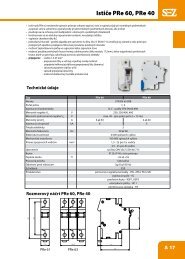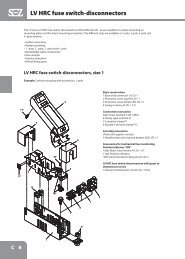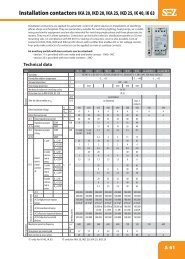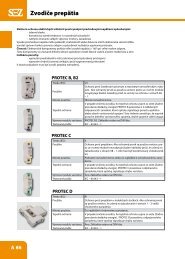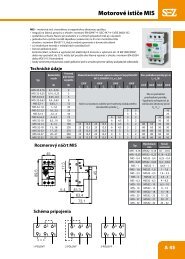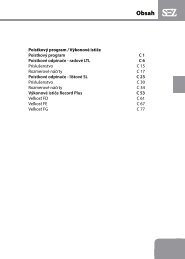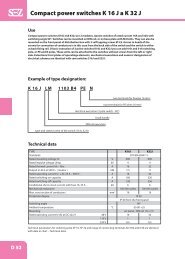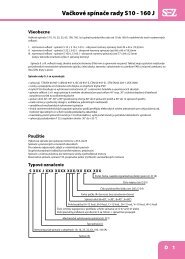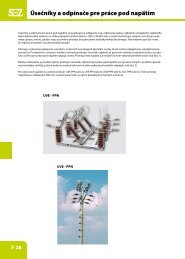Residual current circuit breakers PFB and PCHB - SEZ Krompachy
Residual current circuit breakers PFB and PCHB - SEZ Krompachy
Residual current circuit breakers PFB and PCHB - SEZ Krompachy
Create successful ePaper yourself
Turn your PDF publications into a flip-book with our unique Google optimized e-Paper software.
<strong>Residual</strong> <strong>current</strong> <strong>circuit</strong> <strong>breakers</strong> <strong>PFB</strong> <strong>and</strong> <strong>PCHB</strong><br />
WITH A RESIDUAL CURRENT CIRCUIT BREAKER (RCCB) THE FOLLOWING PROTECTIVE MEASURES ARE<br />
AVAILABLE:<br />
• protection in cases of indirect contact<br />
• protection in cases of direct contact<br />
• prevention of fires caused by ground-fault <strong>current</strong>s<br />
FEATURES<br />
• suitable for protection of electrical <strong>circuit</strong>s in residential buildings,<br />
non-residential buildings or industrial applications<br />
• <strong>PFB</strong> <strong>and</strong> <strong>PCHB</strong> devices are working according IEC 61008-1 / EN 61008-1<br />
• simple <strong>and</strong> solid fixing to 35 mm mounting rail in compliance to EN 6071<br />
• range of rated residual operating <strong>current</strong>s I 10, 30, 100, 300, 500 mA (I = 10mA is for devices with<br />
rated <strong>current</strong> up to 25A include)<br />
• optical indicator, on the front side indicating operating state of device (green target visible closed contacts,<br />
red target visible opened contacts)<br />
• connected clamp headed/stirrupted range of connecting wires 1,5 - 25 mm 2<br />
• working position optional<br />
• there is possibility to use auxiliary contacts for type <strong>PFB</strong><br />
• <strong>PFB</strong> devices are compatible with <strong>circuit</strong> <strong>breakers</strong> PR 60, PRe 60, PR 40e, RV 60, PFI 2 dimensions<br />
<strong>PFB</strong>2 <strong>PFB</strong>4 <strong>PCHB</strong>2 <strong>PCHB</strong>4<br />
TYPES<br />
RCCBs are manufactured in compliance with EN 61008 st<strong>and</strong>ard:<br />
• type A - sensitive to alternating <strong>and</strong> pulsating dc residual operating <strong>current</strong>s.<br />
• type AC - sensitive only to alternating residual operating <strong>current</strong>s of sine form.<br />
SPECIAL VERSIONS<br />
Four-pole selective switches (switches with delayed break-out) are available at customer‘s request. Their rated <strong>current</strong>s are 25,<br />
40 or 63A, <strong>and</strong> rated differential <strong>current</strong>s are 0,1 A or 0,3 A. Break out times at different values of differential <strong>current</strong>s comply<br />
with the EN 61008 st<strong>and</strong>ard.<br />
At customers‘s request, special K switches with delayed tripping time (min. inactive period 10 ms) <strong>and</strong> high resistance to surge<br />
<strong>current</strong>s (up to 3 kA) are also available. Their rated <strong>current</strong>s are 40 or 63 A, <strong>and</strong> their rated differential <strong>current</strong>s are 0,03; 0,1; 0,3<br />
or 0,5 A.<br />
A 39
<strong>Residual</strong> <strong>current</strong> <strong>circuit</strong> <strong>breakers</strong> <strong>PFB</strong> <strong>and</strong> <strong>PCHB</strong><br />
Technical data<br />
Versions <strong>PFB</strong>2 <strong>PFB</strong>4 <strong>PCHB</strong>2 <strong>PCHB</strong>4<br />
Types<br />
A, AC<br />
Number of poles 2 4 2 4<br />
Rated <strong>current</strong> I n<br />
A 16 - 63 16 - 63 16 - 100 16 - 100<br />
Rated residual operating <strong>current</strong> I Dn<br />
A 0,01 - 0,5 0,03 - 0,5 0,01 - 0,5 0,03 - 0,5<br />
Rated voltage U n<br />
V 230 230/400 230 230/400<br />
Rated frequency Hz 50 50 50/60 50/60<br />
Rated res. making <strong>and</strong><br />
breaking capacity I m<br />
I Δm<br />
630 630 800; 1000 for In=100A<br />
Rated res. making <strong>and</strong><br />
breaking capacity<br />
I ∆m<br />
Max. conventional<br />
back-up fuses GL I n<br />
A 63; 80 for In=63 <strong>and</strong> 80A; 100 for In=100A<br />
Rated conditional<br />
short-<strong>circuit</strong> <strong>current</strong> I cn<br />
A 10000; 6000 for In=100A<br />
Protection degree<br />
IP 20; IP40 after installation<br />
Mounting position<br />
optional<br />
Ambient temperature °C from -25°C to +40°C<br />
Weight g 250 435 230 390<br />
Terminal capacity mm 2 1,5 to 25 1 to 35<br />
Accesories auxiliary <strong>and</strong> signal contacts sealing covers<br />
Dimensional drawings of <strong>PFB</strong> <strong>and</strong> <strong>PCHB</strong><br />
69<br />
69<br />
45<br />
35<br />
<strong>PFB</strong> 2 <strong>PFB</strong> 4<br />
69<br />
60<br />
44 5,5<br />
<strong>PCHB</strong> 4 <strong>PCHB</strong> 2<br />
Contacts scheme<br />
<strong>PFB</strong> - 2 <strong>PFB</strong> - 4<br />
<strong>PCHB</strong> - 2 <strong>PCHB</strong> - 4<br />
A 40
<strong>Residual</strong> <strong>current</strong> <strong>circuit</strong> <strong>breakers</strong> <strong>PFB</strong> <strong>and</strong> <strong>PCHB</strong><br />
<strong>PFB</strong> - 2<br />
2 pole version<br />
Ordering Nr.<br />
Type A<br />
Type AC<br />
I ∆n<br />
= 0,01 A<br />
<strong>PFB</strong>2 - 16/0,01 0090660 0090660AC<br />
<strong>PFB</strong>2 - 25/0,01 0090661 0090661AC<br />
I ∆n<br />
= 0,03 A<br />
<strong>PFB</strong>2 - 16/0,03 0090662 0090662AC<br />
<strong>PFB</strong>2 - 25/0,03 0090663 0090663AC<br />
<strong>PFB</strong>2 - 40/0,03 0090664 0090664AC<br />
<strong>PFB</strong>2 - 63/0,03 0090665 0090665AC<br />
I ∆n<br />
= 0,1 A<br />
<strong>PFB</strong>2 - 16/0,1 0090666 0090666AC<br />
<strong>PFB</strong>2 - 25/0,1 0090667 0090667AC<br />
<strong>PFB</strong>2 - 40/0,1 0090668 0090668AC<br />
<strong>PFB</strong>2 - 63/0,1 0090669 0090669AC<br />
I ∆n<br />
= 0,3 A<br />
<strong>PFB</strong>2 - 16/0,3 0090670 0090670AC<br />
<strong>PFB</strong>2 - 25/0,3 0090671 0090671AC<br />
<strong>PFB</strong>2 - 40/0,3 0090672 0090672AC<br />
<strong>PFB</strong>2 - 63/0,3 0090673 0090673AC<br />
I ∆n<br />
= 0,5 A<br />
<strong>PFB</strong>2 - 16/0,5 0090674 0090674AC<br />
<strong>PFB</strong>2 - 25/0,5 0090675 0090675AC<br />
<strong>PFB</strong>2 - 40/0,5 0090676 0090676AC<br />
<strong>PFB</strong>2 - 63/0,5 0090677 0090677AC<br />
<strong>PFB</strong> - 4<br />
4 pole version<br />
Ordering Nr.<br />
Type A<br />
Type AC<br />
I ∆n<br />
= 0,03 A<br />
<strong>PFB</strong>4 - 16/0,03 0090682 0090682AC<br />
<strong>PFB</strong>4 - 25/0,03 0090683 0090683AC<br />
<strong>PFB</strong>4 - 40/0,03 0090684 0090684AC<br />
<strong>PFB</strong>4 - 63/0,03 0090685 0090685AC<br />
I ∆n<br />
= 0,1 A<br />
<strong>PFB</strong>4 - 16/0,1 0090686 0090686AC<br />
<strong>PFB</strong>4 - 25/0,1 0090687 0090687AC<br />
<strong>PFB</strong>4 - 40/0,1 0090688 0090688AC<br />
<strong>PFB</strong>4 - 63/0,1 0090689 0090689AC<br />
I ∆n<br />
= 0,3 A<br />
<strong>PFB</strong>4 - 16/0,3 0090690 0090690AC<br />
<strong>PFB</strong>4 - 25/0,3 0090691 0090691AC<br />
<strong>PFB</strong>4 - 40/0,3 0090692 0090692AC<br />
<strong>PFB</strong>4 - 63/0,3 0090693 0090693AC<br />
I ∆n<br />
= 0,5 A<br />
<strong>PFB</strong>4 - 16/0,5 0090694 0090694AC<br />
<strong>PFB</strong>4 - 25/0,5 0090695 0090695AC<br />
<strong>PFB</strong>4 - 40/0,5 0090696 0090696AC<br />
<strong>PFB</strong>4 - 63/0,5 0090697 0090697AC<br />
<strong>PCHB</strong> - 2<br />
2 pole version<br />
<strong>PCHB</strong>2 - 16/0,01<br />
<strong>PCHB</strong>2 - 25/0,01<br />
<strong>PCHB</strong>2 - 16/0,03<br />
<strong>PCHB</strong>2 - 25/0,03<br />
<strong>PCHB</strong>2 - 40/0,03<br />
<strong>PCHB</strong>2 - 63/0,03<br />
<strong>PCHB</strong>2 - 80/0,03<br />
<strong>PCHB</strong>2 - 100/0,03<br />
<strong>PCHB</strong>2 - 16/0,1<br />
<strong>PCHB</strong>2 - 25/0,1<br />
<strong>PCHB</strong>2 - 40/0,1<br />
<strong>PCHB</strong>2 - 63/0,1<br />
<strong>PCHB</strong>2 - 80/0,1<br />
<strong>PCHB</strong>2 - 100/0,1<br />
<strong>PCHB</strong>2 - 16/0,3<br />
<strong>PCHB</strong>2 - 25/0,3<br />
<strong>PCHB</strong>2 - 40/0,3<br />
<strong>PCHB</strong>2 - 63/0,3<br />
<strong>PCHB</strong>2 - 80/0,3<br />
<strong>PCHB</strong>2 - 100/0,3<br />
<strong>PCHB</strong> - 4<br />
4 pole version<br />
<strong>PCHB</strong>4 - 25/0,03<br />
<strong>PCHB</strong>4 - 40/0,03<br />
<strong>PCHB</strong>4 - 63/0,03<br />
<strong>PCHB</strong>4 - 80/0,03<br />
<strong>PCHB</strong>4 - 100/0,03<br />
<strong>PCHB</strong>4 - 25/0,1<br />
<strong>PCHB</strong>4 - 40/0,1<br />
<strong>PCHB</strong>4 - 63/0,1<br />
<strong>PCHB</strong>4 - 80/0,1<br />
<strong>PCHB</strong>4 - 100/0,1<br />
<strong>PCHB</strong>4 - 25/0,3<br />
<strong>PCHB</strong>4 - 40/0,3<br />
<strong>PCHB</strong>4 - 63/0,3<br />
<strong>PCHB</strong>4 - 80/0,3<br />
<strong>PCHB</strong>4 - 100/0,3<br />
<strong>PCHB</strong>4 - 40/0,5<br />
I ∆n<br />
= 0,01 A<br />
I ∆n<br />
= 0,03 A<br />
I ∆n<br />
= 0,1 A<br />
I ∆n<br />
= 0,3 A<br />
I ∆n<br />
= 0,03 A<br />
I ∆n<br />
= 0,1 A<br />
I ∆n<br />
= 0,3 A<br />
I ∆n<br />
= 0,5 A<br />
Ordering Nr.<br />
Type A<br />
<strong>PCHB</strong>2/721011<br />
<strong>PCHB</strong>2/722011<br />
<strong>PCHB</strong>2/721031<br />
<strong>PCHB</strong>2/722031<br />
<strong>PCHB</strong>2/724031<br />
<strong>PCHB</strong>2/726031<br />
<strong>PCHB</strong>2/728031<br />
<strong>PCHB</strong>2/7210031<br />
<strong>PCHB</strong>2/721101<br />
<strong>PCHB</strong>2/722101<br />
<strong>PCHB</strong>2/724101<br />
<strong>PCHB</strong>2/726101<br />
<strong>PCHB</strong>2/728101<br />
<strong>PCHB</strong>2/7210101<br />
<strong>PCHB</strong>2/721301<br />
<strong>PCHB</strong>2/721301<br />
<strong>PCHB</strong>2/724301<br />
<strong>PCHB</strong>2/726301<br />
<strong>PCHB</strong>2/728301<br />
<strong>PCHB</strong>2/7210301<br />
Ordering Nr.<br />
Type A<br />
<strong>PCHB</strong>4/742031<br />
<strong>PCHB</strong>4/744031<br />
<strong>PCHB</strong>4/746031<br />
<strong>PCHB</strong>4/748031<br />
<strong>PCHB</strong>4/7410031<br />
<strong>PCHB</strong>4/742101<br />
<strong>PCHB</strong>4/744101<br />
<strong>PCHB</strong>4/746101<br />
<strong>PCHB</strong>4/748101<br />
<strong>PCHB</strong>4/7410101<br />
<strong>PCHB</strong>4/742301<br />
<strong>PCHB</strong>4/744301<br />
<strong>PCHB</strong>4/746301<br />
<strong>PCHB</strong>4/748301<br />
<strong>PCHB</strong>4/7410301<br />
<strong>PCHB</strong>4/744501<br />
A 41
<strong>Residual</strong> <strong>current</strong> <strong>circuit</strong> <strong>breakers</strong> <strong>PFB</strong> <strong>and</strong> <strong>PCHB</strong><br />
Instantaneous tripping characteristics <strong>PCHB</strong><br />
BASIC TERMS AND SYMBOLS<br />
•Rated residual <strong>current</strong> I ∆n<br />
is the value of residual <strong>current</strong> I ∆n<br />
specified by the manufacturer at which the residual <strong>current</strong> <strong>circuit</strong><br />
breaker must switch out under specified conditions. Alternating<br />
residual <strong>current</strong> must release the residual <strong>current</strong> <strong>circuit</strong><br />
breaker within (0.5 ÷ 1) I ∆n<br />
•Rated conditional short-<strong>circuit</strong> <strong>current</strong> I nc<br />
– short-<strong>circuit</strong><br />
strength. The function <strong>and</strong> design principle does not allow for<br />
the residual <strong>current</strong> <strong>circuit</strong> breaker use for protection against<br />
short-<strong>circuit</strong>. For <strong>circuit</strong> protection it is necessary to use a <strong>circuit</strong><br />
breaker or a fuse. These elements cut the short-<strong>circuit</strong>ed<br />
<strong>circuit</strong> safely off . The residual <strong>current</strong> <strong>circuit</strong> breaker must only<br />
withst<strong>and</strong> the through-going short-<strong>circuit</strong> <strong>current</strong>. The amplitude<br />
of the maximum through <strong>current</strong> is defined as rated conditional<br />
short-<strong>circuit</strong> <strong>current</strong> I nc<br />
. The short-<strong>circuit</strong> strength is then<br />
expressed by the <strong>current</strong> Inc. For example, on the rating plate, I nc<br />
= 10 kA is expressed by the following symbol:<br />
•<strong>Residual</strong> <strong>current</strong> <strong>circuit</strong> breaker – type AC – reacts to sine-wave<br />
residual <strong>current</strong> – it is used in conventional AC networks.<br />
•<strong>Residual</strong> <strong>current</strong> <strong>circuit</strong> breaker – type A – reacts to sine-wave<br />
alternating <strong>and</strong> pulsating direct residual <strong>current</strong>s - it is used in<br />
conventional AC networks <strong>and</strong> the networks with phase power<br />
regulation etc.<br />
•<strong>Residual</strong> <strong>current</strong> <strong>circuit</strong> breaker – type G – special residual<br />
<strong>current</strong> <strong>circuit</strong> breaker reducing the number of undesirable releases.<br />
It is mainly installed before the devices causing short-time<br />
(up to 10 ms) stray <strong>current</strong>s.<br />
Identifi cation: G<br />
Release delay: 10 ms<br />
•<strong>Residual</strong> <strong>current</strong> <strong>circuit</strong> breaker – type S – special residual<br />
<strong>current</strong> <strong>circuit</strong> breaker, which is mainly intended for selective<br />
switching of residual <strong>current</strong> <strong>circuit</strong> <strong>breakers</strong> <strong>and</strong> reduction of<br />
undesirable releases. It is installed before the devices causing<br />
short-time (up to 40 ms) stray <strong>current</strong>s. Identification: S release<br />
delay: 40 ms Selective (discriminating) switching means that if<br />
the residual <strong>current</strong> <strong>circuit</strong> <strong>breakers</strong> are connected in series, only<br />
the device in which <strong>circuit</strong> a failure occurs will release. More specifically,<br />
only the device in which the release residual <strong>current</strong><br />
appears due to a failure in the protected <strong>circuit</strong> will release. The<br />
advantage consists in maintaining the power supply in the other<br />
<strong>circuit</strong>s not aff ected by the failure. Such function of the protected<br />
<strong>circuit</strong> is achieved by connection of the selective residual<br />
<strong>current</strong> <strong>circuit</strong> breaker before the st<strong>and</strong>ard or G type residual<br />
<strong>current</strong> <strong>circuit</strong> breaker, with the following ratio of rated residual<br />
<strong>current</strong>s: I ∆n S<br />
≥ 3 x I ∆n -,G<br />
I ∆nS<br />
rated residual of the selective residual<br />
<strong>current</strong> <strong>circuit</strong> breaker I ∆n -,G<br />
maximum rated residual <strong>current</strong> of G<br />
type residual <strong>current</strong> <strong>circuit</strong> breaker. The main reason of selective<br />
switching is higher time delay of the selective residual <strong>current</strong><br />
<strong>circuit</strong> <strong>breakers</strong> in releasing (compared to st<strong>and</strong>ard or G type<br />
ones).<br />
A 42




